Home
A comprehensive resource for safe and responsible laser use
Worldwide: Computer presentation remote has no laser pointer due to brightness, safety concerns
Kensington’s new $99 Ultimate Presenter with Virtual Pointer instead uses a software program to create an on-screen dot to highlight PowerPoint and similar computer presentations.
The company noted that “[b]right LED screens or safety regulations can pose limitations with traditional lasers.” A spokesperson said “The presenter overcomes the screen limitations and regulatory restrictions of traditional laser pointers….”
The screen limitations referred to are that bright screens can wash out a laser dot, especially a relatively dim dot such as the one from a Class 2 (<1mW) red pointer.
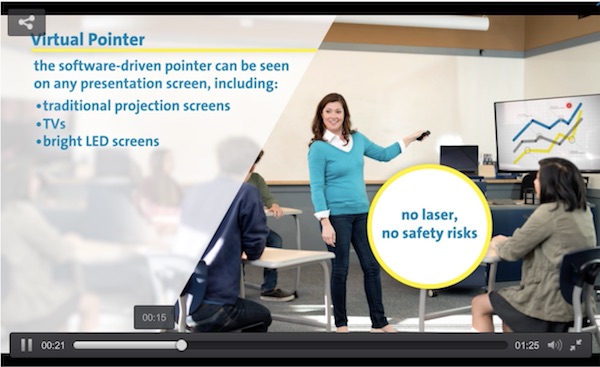
Screenshot from a Kensington video. In the background, the red dot is the software “laser pointer” dot.
Kensington also continues to sell a line of presentation remotes that use red or green laser pointers.
From a September 26 2017 Kensington press release
Sweden: Study of 47 laser eye injury cases from 2013 to 2015
The main body of the 2015 study includes an analysis of the laser power versus the observed injuries.
The authors note “If the availability of the handheld lasers continues to increase, along with higher optical power and lower cost, we expect that the number of severe eye injuries will continue to grow. Also, the distance from which the lasers can be used to disrupt various societal functions, such as air traffic (pilots) and policing will also increase. Almost all the reported cases involve young children and teenagers. There is also a huge overrepresentation by males. Often the lasers are sold as toys and purchased by a relative as a gift to a child. Earlier reports originated almost exclusively from developed countries. This situation has now changed and more and more reports originate from developing countries. The problem is worldwide and hence there is a need to educate and inform the societies of this danger.”
The 47 new cases are listed in an appendix. Here is a random sample listing two of the cases:
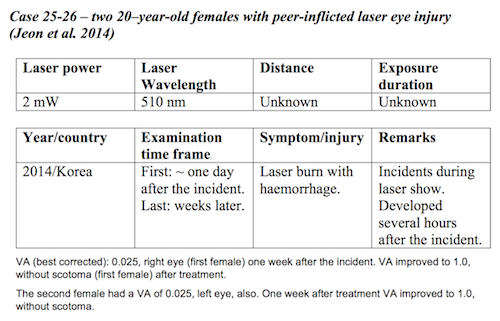
Author: Jörgen Thaung, Cesar Lopes and Stefan Löfgren
Publisher: Strål Säkerhets Myndigheten (SSM - Swedish Radiation Safety Authority)
Language: English
Publication date: December 2015
No of pages: 45
Price per publication: 100 SEK (incl. VAT)
Download: 2015:54 Retinal injuries from handheld lasers: An updated report [2200 kb]
A summary by LaserPointerSafety.com of the study’s objectives, major findings, and conclusion is here. The earlier 2013 study is summarized here and the full SSM document is available here.
General: How many laser pointers to kill a human?
Author Adam Clark Estes begins with a primer on laser light, and determines that the beams from many lasers would have to be focused on a single spot. Estes quoted Dr. Rebecca Thompson of the American Physical Society:
“…if you wanted to create a death ray with laser pointers, you could buy 200,000 laser pointers [cat-toy type with 5 milliwatt output each], mount them on a piece of a sphere with radius 5.5’, aim them all through a lens and ask your victim to sit very, very still.”
The article concludes “Do not try this at home.”
From Gizmodo. Thanks to Roberta McHatton for bringing this to our attention.
Worldwide: Star Wars drones feature aerial laser battles
The “Star Wars Battle Quads” can move at speeds of 40-50 mph, and have clear propellers on the bottom to help maintain the illusion of a Millennium Falcon, X-Wing, TIE fighter or speeder bike flying on its own.
According to the manufacturer, Propel, up to 24 drones can have a laser battle simultaneously. A publicity photo shows laser beams clearly visible in a smoky environment:
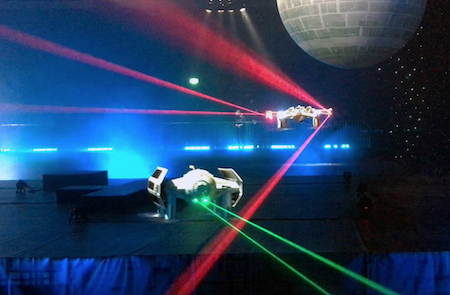
Below is a freeze-frame from a Propel video that shows the drones (upper left corner) flying in a public demonstration. The circles show where the laser beams are shooting onto an audience.
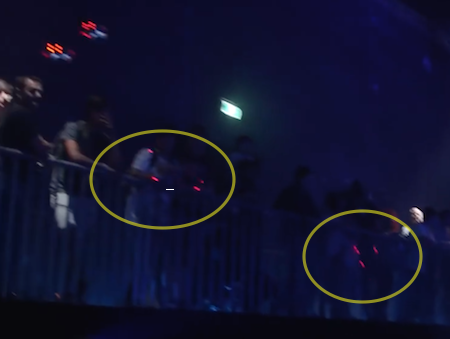
According to the Verge, “When a ship is hit by a laser from an opposing ship, its paired controller … shakes in the pilot’s hands. After three direct hits, the drone will slowly spiral to the ground the game is over. Although the prototypes weren’t ready for one of these battles when we saw them, the lasers alone were pretty striking.”
The caption of this photo from the Verge states that the lasers are “Around the strength of a laser pointer.” Empire vehicles have green lasers, Rebellion vehicles have red.
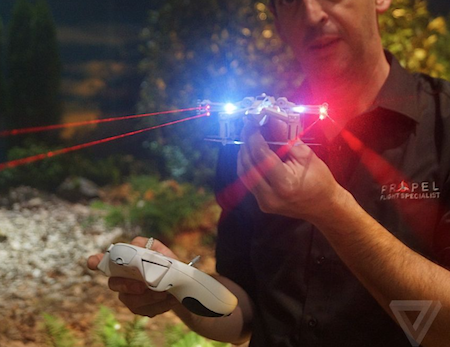
The cost is reported to be between $200-$400.
From Wired, Engadget and the Verge. Freeze-frame from a video in a PC Mag article.
Worldwide: Wicked Lasers to stop shipping high-powered lasers to U.S. on Jan. 1 2015
The sales restriction does not seem to be the result of any particular regulatory actions or other outside forces; instead it appears to be a decision by the “new ownership and management” that was also announced at the same time.
Wicked currently sells handheld lasers up to 2000 milliwatts (2 watts). In the U.S., lasers sold as “pointers” or for pointing purposes must be below 5 milliwatts output power; handheld battery-powered lasers over that power may still be sold legally if they are not “pointers” and if they meet FDA safety requirements for their laser class. All Wicked Lasers sold in 2015 will thus be within the U.S. “pointer” range of power.
The announcement came with a 40% off sale, so the company will still be shipping high-powered lasers through December 31 2014.
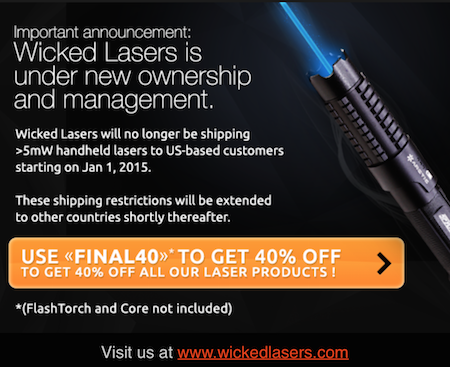
From the email announcement Wicked Lasers sent to customers on Nov. 19 2014 (shown above).
Worldwide: Audi introduces laser headlights; follows BMW's lead

Audi Sport Quattro concept car
BMW also has introduced laser headlights, on its electric supercar i8.
The headlights use laser diodes to energize a phosphor that creates white light. According to Audi, the beams have a range of 1640 feet, twice the distance of LED high beams.
Technically, the white-light beam would not have the same coherence as a laser, making it safer for human vision (at least, at normal driving distances -- any very bright light viewed up close could be an eye hazard). An Audi spokesperson said “Our main aim was to not dazzle any drivers, laser technology is much more accurate.”
Because the laser diodes are so tiny -- only a few micrometers in diameter -- the headlight assembly itself can be made smaller as well.
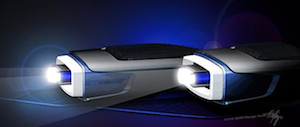
Closeup of the Audi laser headlights
The laser power appears to be about 10 watts, based on an Australian report that “the system is 10,000 times more powerful than a laser pointer”. Such pointers in Australia are limited to 1 milliwatt or 1/1000 watt. It is unclear if this refers to the total power of both headlights, or of a single headlight.
From Car and Driver, and News.com.au. MotorTrend has an excellent article from 2011 describing in detail how the BMW laser headlights work. It contains an account where journalists looked directly into the light without adverse effect.
Sweden: Detailed study released of worldwide laser pointer eye injuries
“The purpose of this study was to investigate what dose of laser radiation, in terms of intensity and exposure time, may be associated with eye damages. The study has been limited to unwanted exposures of laser radiation from commercially available laser pointers. Of particular interest has been to search for data that clarify the dose-response relationships for functional disabilities that persist more than 6 months.”
“The study shows that long-term vision loss can occur as a result of involuntary exposure from commercially available (strong) laser pointers at close range. The injury may occur before a normal person is able to respond by closing the eyelid, although there are only a few cases reported. A minor such damage is transient within a few days. It is also likely that such a visible injury to the retina becomes functional, i.e. prevents reading skills. What dosage is required for the disability to become permanent is not clear in the literature. Also, the dynamics of evolvement and repair of tissue damages and disabilities are hardly described at all.”
Author: Stefan Löfgren, Jörgen Thaung and Cesar Lopes
Publisher: Strål Säkerhets Myndigheten (SSM - Swedish Radiation Safety Authority)
Language: English
Publication date: 19 November 2013
No of pages: 50
Price per publication: 100 SEK (incl. VAT)
Download: 2013:30 Laser pointers and Eye injuries - An analysis of reported cases [1385 kb]
A summary by LaserPointerSafety.com of the study’s objectives, major findings, and conclusion is here.
UPDATED January 2016: The SSM released an update, with 47 additional cases worldwide of eye injuries from consumer lasers. A summary by LaserPointerSafety.com is here; the full SSM document is here.
Worldwide: Concern over laser dazzling of satellites
“There are lasers used to hit satellites, it’s called dazzling, and it’s a show of force. There are a handful of countries that can do it. China dazzles U.S. and French satellites in low earth orbit not often, but regularly. What if a laser hits them, maybe lingers too long? A show of force can actually damage the satellite, knocks out some sensitive equipment. If that happens, and it’s from China, is that an act of war? What do you do? Political leaders have to be briefed on this. They have to make an effort to avoid escalation.”
From an interview in the Santa Barbara Independent conducted by Kevin Zambrano
World: Laser pointer focus/aiming aid for cameras
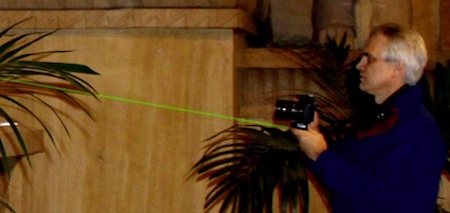
A promotional photo demonstrating the concept of the PinPoint Focus Assist
The manufacturer says the PinPoint complies with U.S. FDA safety regulations. It is said to be a Class 2 green DPSS diode with output power less than 1 milliwatt. The focus range is from 2.5ft/7.5m to 131ft/40m; the aiming range is 700ft/210m in low-light and “further in darkness”.
At their website, DeluxGear has an admirable list of safety warnings which include:
- Don’t aim at a person’s eyes. This can cause “temporary vision dysfunction such as flash blindness, disorientation or glare. This can be particularly dangerous if the exposed person is engaged in a vision-critical activity such as driving or other means of transportation.”
- Don’t aim it at a person without notifying them in advance.
- Don’t aim at a law enforcement officer as this is illegal in many jurisdictions.
- Never aim at vehicles including aircraft.
- Don’t allow a minor to use unsupervised. In some jurisdictions it is illegal for a minor to purchase or use a laser product
Incidentally, the beam on/off function is separate from the camera. This means the beam does NOT come on when the shutter button is pressed, but instead is controlled by a separate switch on the PinPoint.
From DeluxGear; click on the “Protect Your Gear” menu to read the list of safety warnings.
.
Worldwide: Laser pointers reach 2000 milliwatts (2 watts)
To give an idea of its power, here are some comparisons:
- The U.S. limit for a laser to be sold as a pointer is 5 mW (0.005 watt). The new lasers are 400 times more powerful than a “legal” laser pointer.
- The infamous Wicked Laser Spyder III Arctic is nominally a 1000 mW laser (1 watt). However, most Arctics actually emit around 800 mW, so if the new lasers really reach 2000 mW then they are 2.5 times as powerful as a Wicked Arctic.
- The most dangerous laser classification, Class 4, begins at 500 mW (1/2 watt) for visible light. Class 4 lasers can cause instant eye damage, skin burns, and can be a fire hazard for certain materials. The new devices are four times the minimum for a Class 4 laser.
- A 2000 mW laser is an eye hazard up to about 1,000 feet away from the laser.
Worldwide: Warning from Casio about misuse of its laser diodes
WARNING!
Casio America, Inc. (“Casio”) has recently learned that potentially dangerous handheld laser pointer devices are being marketed and sold by Wicked Lasers, Ltd. (and possibly others) that are believed to incorporate laser diodes improperly removed from Casio XJ-A series projectors. Casio has never authorized this unintended and potentially dangerous misuse of the light source component of its XJ-A series Projectors.
Casio specifically instructs and warns purchasers of its XJ-A series projectors that disassembly or modification of the built-in laser module is “very dangerous and should never be attempted,” and would like to take this opportunity to remind the laser enthusiast community of that fact. The unauthorized, unintended and potentially dangerous misuse of the laser diodes improperly removed from Casio XJ-A series projectors for use in these handheld lasers, such as Wicked Lasers’ SPYDER III, may create a substantial risk of fire and injury to users and others. Casio intends to pursue Wicked Lasers and any other companies that violate Casio’s rights by misusing components of its XJ-A projectors or other products to the fullest extent of the law.
At the same time, Casio strongly urges consumers to avoid these unauthorized and potentially dangerous “laser pointers” such as the SPYDER III.
Worldwide: Dangerous 1 watt laser on sale for only $200 (+ updates)
Wicked Lasers advertises the 1 watt Spyder III Pro Arctic as “the most dangerous laser ever created”. This is not far from the truth; it is by far the most dangerous laser affordable by the general public. Previously, such a laser would have cost many thousands of dollars.Click to read more...